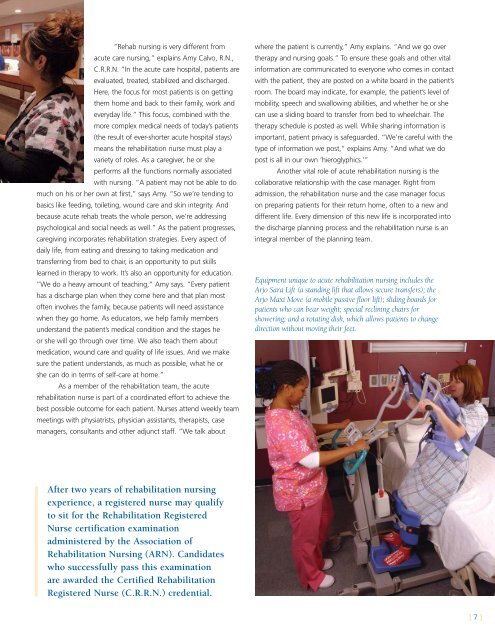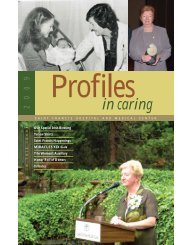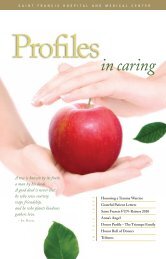2009 Annual Report - Saint Francis Hospital and Medical Center
2009 Annual Report - Saint Francis Hospital and Medical Center
2009 Annual Report - Saint Francis Hospital and Medical Center
You also want an ePaper? Increase the reach of your titles
YUMPU automatically turns print PDFs into web optimized ePapers that Google loves.
“Rehab nursing is very different from<br />
acute care nursing,” explains Amy Calvo, R.N.,<br />
C.R.R.N. “In the acute care hospital, patients are<br />
evaluated, treated, stabilized <strong>and</strong> discharged.<br />
Here, the focus for most patients is on getting<br />
them home <strong>and</strong> back to their family, work <strong>and</strong><br />
everyday life.” This focus, combined with the<br />
more complex medical needs of today’s patients<br />
(the result of ever-shorter acute hospital stays)<br />
means the rehabilitation nurse must play a<br />
variety of roles. As a caregiver, he or she<br />
performs all the functions normally associated<br />
with nursing. “A patient may not be able to do<br />
much on his or her own at first,” says Amy. “So we’re tending to<br />
basics like feeding, toileting, wound care <strong>and</strong> skin integrity. And<br />
because acute rehab treats the whole person, we’re addressing<br />
psychological <strong>and</strong> social needs as well.” As the patient progresses,<br />
caregiving incorporates rehabilitation strategies. Every aspect of<br />
daily life, from eating <strong>and</strong> dressing to taking medication <strong>and</strong><br />
transferring from bed to chair, is an opportunity to put skills<br />
learned in therapy to work. It’s also an opportunity for education.<br />
“We do a heavy amount of teaching,” Amy says. “Every patient<br />
has a discharge plan when they come here <strong>and</strong> that plan most<br />
often involves the family, because patients will need assistance<br />
when they go home. As educators, we help family members<br />
underst<strong>and</strong> the patient’s medical condition <strong>and</strong> the stages he<br />
or she will go through over time. We also teach them about<br />
medication, wound care <strong>and</strong> quality of life issues. And we make<br />
sure the patient underst<strong>and</strong>s, as much as possible, what he or<br />
she can do in terms of self-care at home.”<br />
As a member of the rehabilitation team, the acute<br />
rehabilitation nurse is part of a coordinated effort to achieve the<br />
best possible outcome for each patient. Nurses attend weekly team<br />
meetings with physiatrists, physician assistants, therapists, case<br />
managers, consultants <strong>and</strong> other adjunct staff. “We talk about<br />
After two years of rehabilitation nursing<br />
experience, a registered nurse may qualify<br />
to sit for the Rehabilitation Registered<br />
Nurse certification examination<br />
administered by the Association of<br />
Rehabilitation Nursing (ARN). C<strong>and</strong>idates<br />
who successfully pass this examination<br />
are awarded the Certified Rehabilitation<br />
Registered Nurse (C.R.R.N.) credential.<br />
where the patient is currently,” Amy explains. “And we go over<br />
therapy <strong>and</strong> nursing goals.” To ensure these goals <strong>and</strong> other vital<br />
information are communicated to everyone who comes in contact<br />
with the patient, they are posted on a white board in the patient’s<br />
room. The board may indicate, for example, the patient’s level of<br />
mobility, speech <strong>and</strong> swallowing abilities, <strong>and</strong> whether he or she<br />
can use a sliding board to transfer from bed to wheelchair. The<br />
therapy schedule is posted as well. While sharing information is<br />
important, patient privacy is safeguarded. “We’re careful with the<br />
type of information we post,” explains Amy. “And what we do<br />
post is all in our own ‘hieroglyphics.’”<br />
Another vital role of acute rehabilitation nursing is the<br />
collaborative relationship with the case manager. Right from<br />
admission, the rehabilitation nurse <strong>and</strong> the case manager focus<br />
on preparing patients for their return home, often to a new <strong>and</strong><br />
different life. Every dimension of this new life is incorporated into<br />
the discharge planning process <strong>and</strong> the rehabilitation nurse is an<br />
integral member of the planning team.<br />
Equipment unique to acute rehabilitation nursing includes the<br />
Arjo Sara Lift (a st<strong>and</strong>ing lift that allows secure transfers); the<br />
Arjo Maxi Move (a mobile passive floor lift); sliding boards for<br />
patients who can bear weight; special reclining chairs for<br />
showering; <strong>and</strong> a rotating disk, which allows patients to change<br />
direction without moving their feet.<br />
[ 7 ]





